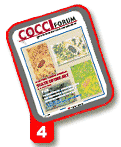Cover Story - Technically Speaking
Dr. Martin Shirley on making your coccidiosis control program state of the art
 Martin Shirley, PhD
Institute for Animal Health,
Compton Laboratory
Compton-Newbury, U.K.
|
For over 50 years, coccidiosis control
in intensively reared broiler
chickens has depended on a constant
stream of new products. In the
past, virtually all introductions have
been anticoccidial drugs. For the foreseeable
future, however, no new drugs
can be expected, and it appears that
only vaccines will provide the necessary
innovation and new options.
Although live vaccines have been
available commercially for many years,
it is only recently that the momentum
for their use has increased due to the
availability of a new generation of live
vaccines that are based on safer, precocious
lines of parasites. In addition,
concern among retailers over the use of
feed additives and possible implications
for human health have favored an
increasingly "greener" approach to
farming.
Replacing dietary prophylactic drugs
with vaccination offers tangible practical
advantages. For example, the elimination
of 3- to 5-day drug withdrawal
periods means that birds of a target
weight can be removed from a flock
whenever they are needed. In other
words, producers now have it within
their power to make their coccidiosis
control program more flexible, meeting
market demands.
Immune Detection
Seven species of Eimeria enter the
body of the chicken. They are located
within host cells deep inside the gut
and are entirely dependent on the host
for nutrition as they undergo massive
rates of growth and multiplication.
Within just a few hours alter ingesting
oocysts, the host chicken begins to
respond to the infection; by around 4
days, it will have mounted the start of a
specific protective immune response.
The potency of this response varies
depending on a variety of factors such
as the size of the infective dose, but
even a chicken exposed to a single
intake of small oocyst numbers will
develop substantial immunity to further
challenge.
The Anticoccidial Drug Era
The first comprehensive descriptions of
most avian coccidia were made in the
1920s and 1930s. Within just a few
years, the efficacy of inorganic sulphur
for preventing caecal coccidiosis was
reported and opened the way for the
introduction of new anticoccidial drugs
into the marketplace.
The variety of different chemical
drugs introduced initially was superseded
at the beginning of the 1970s by the
most successful of all anticoccidials -
the ionophorous antibiotics. Unlike
many "totally" effective chemical drugs
that readily gave rise to resistant
mutants, the ionophores were intrinsically
less effective and each newly
introduced drug allowed some parasites
to develop and complete their life
cycle during the course of every infection.
This unique mode of action
imposed weak selection pressures on
coccidia and drug-resistant mutants
were not reported for many years.
Ultimately, resistant strains to
ionophores appeared, but the drugs
have continued to remain the mainstay
of coccidiosis control. The use of
ionophores, however, is now tempered
by the need to manage the high incidence
of drug-resistant strains. This is
usually achieved through the implementation
of drug shuttle programmes.
The huge success of ionophores in
conjunction with the more limited use
of other drugs has almost certainly
been one reason why several animal health companies have reduced their
search for, or interest in, the development
of new anticoccidial drugs. Other
factors that have impacted negatively
on research to derive new drugs
include the spiralling costs of product
development and changing political
perceptions about the role of feed additives.
A dramatic decline in the pace of
new introductions has thus followed
the success of the ionophores; no new
anticoccidials were made available during
the 1990s. Moreover, reports of
potentially active compounds completing
the first phase of investigation are
now sparse and it appears that no new
drugs can be anticipated for the foreseeable
future.
Bridging Drugs and Vaccines
Against the backdrop of coccidiosis
control by chemotherapy and the need
for the poultry industry to adjust the
use of individual drugs as their efficacy
is compromised by drug resistance,
immunity to parasites has played an
interesting and increasingly prominent
role during the past 10 to 20 years. One
investigator theorized that the development
of host immunity is a major factor
accounting for the effectiveness of
polyether ionophores, despite the existence
of resistant strains of field coccidia.
It is thus possible to think that some
of the drugs, especially the ionophores,
have for many years been acting in
concert with background coccidial
infection to function as "surrogate vaccines"
by maintaining low levels (trickle
doses) of infection that have immunised
the hosts in the absence of disease.
New Control Strategies
Over 20 years ago, it became clear to
many scientists that the rich genetic
diversity of coccidia would require
introduction of new control strategies if
the parasites were to be controlled
effectively in the long term. In other
words, the almost blanket use of
chemotherapy would not be adequate.
Immunoprophylaxis "the prevention
of disease by utilizing natural
immunity "largely remained neglected,
although progress was made in the
mid-1970s and throughout the 1980s on
the selection of attenuated parasites
that would provide the basis of a new
generation of live vaccines.
The use of small numbers of normal,
"wild-type" parasites
(e.g., those recovered from
the field) as vaccine components
can be very successful
if the delivery system
is optimised so that
most or all chickens within
a flock ingest vaccinal
oocysts around the same
time. Unfortunately, failure
to achieve uniform administration
could result in
heavy infections in nonvaccinated
birds that were
exposed to large numbers
of oocysts produced by
vaccinal oocysts as they
recycle through the flock.
Thus, the first-generation
live vaccines were very
effective at generating protective
immunity in the
host, but they had a comparatively
restricted window of safety.
'Precocious' Lines
One objective of the search for new
vaccine candidates was to derive "modified"
parasites that would be protective
but offer a greater margin for safety. It
was anticipated that such candidates
would therefore be eminently suitable
for use in broiler production, where a
larger margin of safety is required due
to high stocking density and the precise
economic production targets that are
sought. The so-called "precocious" lines
of Eimeria spp. fit the bill exactly and
provided an ideal combination of:
"� Potent immunogenicity (immunising
the chicken as effectively as wild-type
strains)
"� Attenuation of virulence
"� Reproduction that enables them to be
used as "one-administration" vaccines
Species for a Broiler Vaccine
Of the seven species of avian coccidia,
those encountered most frequently in
broiler chickens worldwide are the
pathogenic species E. acervulina, E.
maxima and E. tenella. These three
species will therefore form the basis of
any live vaccine.
Eimeria brunetti and E. necatrix are
highly pathogenic, but they tend to be
found in older birds and are uncommon
in broilers. Conversely, E. praecox
is regarded as relatively benign and not
a significant contributor to the general
picture of coccidiosis, even though it is
common in broilers.
For European flocks, E. mitis must
be considered. It is significantly pathogenic
but infections with this species
are not revealed by the appearance of
gross lesions that can be assessed by
visual inspection with the naked eye.
The contribution of E. mitis to subclinical
coccidiosis has almost certainly
been underestimated.
Drug-Sensitive Strains
It seems entirely logical that live coccidiosis
vaccines will not be used concurrently
with anticoccidial drugs and
that each approach will be regarded as
totally sufficient.
Since live vaccines will be used
alone, the choice of drug-sensitive
strains of Eimeria as their basis will be
advantageous. For example, the use of
such a product instead of anticoccidial
drugs will introduce drug-sensitive
oocysts into the environment and the
incidence of drug-resistant strains will
be expected to fall as they become
diluted out.
Methods of administering coccidiosis
vaccines to ensure more uniform
application also have been developed.
Necrotic Enteritis
It is clear that both vaccines and anticoccidial
drugs can achieve excellent
coccidiosis control. Both options also
have strengths and weaknesses.
For example, the activity of the
antibiotic ionophores includes antibacterial
effects; there is a perception by
some within the poultry industry that
with vaccination, the incidence of
necrotic enteritis (NE) will rise, since
vaccines will not have similar controlling
effects of Clostridium perfringens.
Interestingly, some of the first comprehensive
data describing the use of live
vaccines in broilers revealed more
cases of NE in medicated control flocks.
A better understanding of the epidemiology
of NE is most definitely
required; the multiple factors that
underpin cases of NE and any relationship
between attenuated and/or wildtype
coccidial parasites and Clostridium
needs to be determined in the context
of modern poultry practices and
nutrition. (See article, page 18.)
Conclusion
Safe and effective vaccines based on
precocious lines and improved methods
of vaccine administration are available.
There is also growing concern
over the use of feed additives in poultry
and increased demand for "greener"
poultry production methods. These factors
have led to an increasing interest in
the worldwide availability of vaccines
for use in broiler chickens.
Whatever lies ahead for the control
of coccidiosis, it is beyond doubt that
coccidia cannot go about their lifestyle
of parasitism without the host declaring
immunological war. Harnessing that
rapid immune response can provide
producers with state-of-the-art coccidiosis
control and vaccination promises to
be a powerful tool for the poultry
industry well into the future.
Source: CocciForum Issue No.4, Schering-Plough Animal Health.







